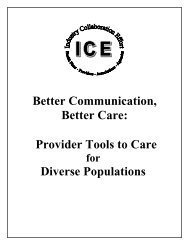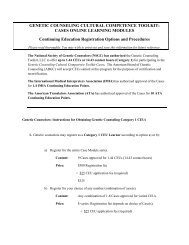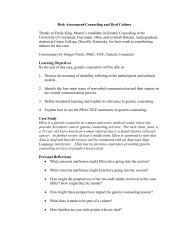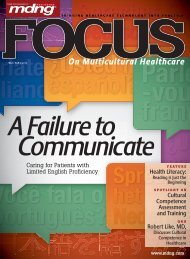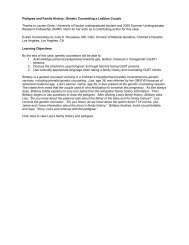Advanced Effective Communication, Cultural Competence, and ...
Advanced Effective Communication, Cultural Competence, and ...
Advanced Effective Communication, Cultural Competence, and ...
Create successful ePaper yourself
Turn your PDF publications into a flip-book with our unique Google optimized e-Paper software.
A Roadmap for Hospitals<br />
Chapter Six: Organization Readiness<br />
Table 6-4. The Seven Principles of<br />
Universal Design<br />
1. Equitable Use. The design is useful <strong>and</strong><br />
marketable to people with diverse abilities.<br />
2. Flexibility in Use. The design accommodates<br />
a wide range of individual preferences <strong>and</strong><br />
abilities.<br />
3. Simple <strong>and</strong> Intuitive Use. Use of the design is<br />
easy to underst<strong>and</strong>, regardless of the user’s<br />
experience, knowledge, language skills, or<br />
current concentration level.<br />
4. Perceptible Information. The design<br />
communicates necessary information<br />
effectively to the user, regardless of ambient<br />
conditions or the user’s sensory abilities.<br />
5. Tolerance for Error. The design minimizes<br />
hazards <strong>and</strong> the adverse consequences of<br />
accidental or unintended actions.<br />
6. Low Physical Effort. The design can be used<br />
efficiently <strong>and</strong> comfortably <strong>and</strong> with a minimum<br />
of fatigue.<br />
7. Size <strong>and</strong> Space for Approach <strong>and</strong> Use.<br />
Appropriate size <strong>and</strong> space is provided for<br />
approach, reach, manipulation, <strong>and</strong> use<br />
regardless of the user’s body size, posture, or<br />
mobility.<br />
Source: The Center for Universal Design: The Principles<br />
of Universal Design, Version 2.0. Raleigh, NC: North<br />
Carolina State University, 1997. Available at:<br />
http://www.design.ncsu.edu/cud/about_ud/udprinciples<br />
htmlformat.html#top. (Accessed on March 2, 2010.)<br />
• Designate an area of the hospital for patients <strong>and</strong> their<br />
families to pray or observe religious services.<br />
❑ Develop a system to provide language<br />
services.<br />
The provision of safe, quality care requires effective<br />
patient–provider communication. Hospitals must develop<br />
a system to provide language services to address the<br />
communication needs of patients whose preferred<br />
language is not English, including patients who<br />
communicate through sign language.<br />
• Establish a centralized budget to provide language<br />
services throughout the hospital.<br />
Helpful Tip: Determine Which<br />
Written Materials to Translate<br />
Written information can be difficult to classify as “vital” or<br />
“nonvital.” Additionally, some documents contain both vital<br />
<strong>and</strong> nonvital information. Consider whether the written<br />
materials have a clinical, legal, or other important<br />
consequence to help determine which documents need to<br />
be translated.<br />
Source: Office for Civil Rights: Guidance to Federal<br />
Financial Assistance Recipients Regarding Title VI<br />
Prohibition Against National Origin Discrimination Affecting<br />
Limited English Proficient Persons. Washington, DC:<br />
U.S. Department of Health <strong>and</strong> Human Services Office for<br />
Civil Rights, 2003. Available at http://www.hhs.gov/ocr/<br />
civilrights/resources/specialtopics/ep/policyguidance<br />
document.html. (Accessed March 2, 2010.)<br />
• Determine the types of language services the hospital<br />
provides or needs to provide, including bilingual care<br />
providers, language interpreters, <strong>and</strong> translators either<br />
on staff or provided by an external vendor for<br />
contracted language services.<br />
• Identify the methods used to provide language<br />
services (for example, in-person, telephone, or<br />
video remote interpreting).<br />
• Consider the number of frequently encountered<br />
languages <strong>and</strong> languages less commonly encountered<br />
when determining the composition of language<br />
services.<br />
• Offer a mixture of language services based on the<br />
needs of the patient population so that services are<br />
available 24 hours a day, 7 days a week.<br />
• Provide translated written documents for frequently<br />
encountered languages to meet patient communication<br />
needs. Determine which documents <strong>and</strong> languages<br />
need to be translated to meet the needs of the patient<br />
population. Table 6-5, on page 41, presents a list of<br />
vital <strong>and</strong> nonvital documents hospitals may consider<br />
when determining which documents to translate.<br />
• Consider developing pre-recorded sign language video<br />
content for commonly used patient education<br />
materials to meet the needs of deaf patients.<br />
• Incorporate language services information, such as<br />
types of services <strong>and</strong> qualifications for language<br />
40


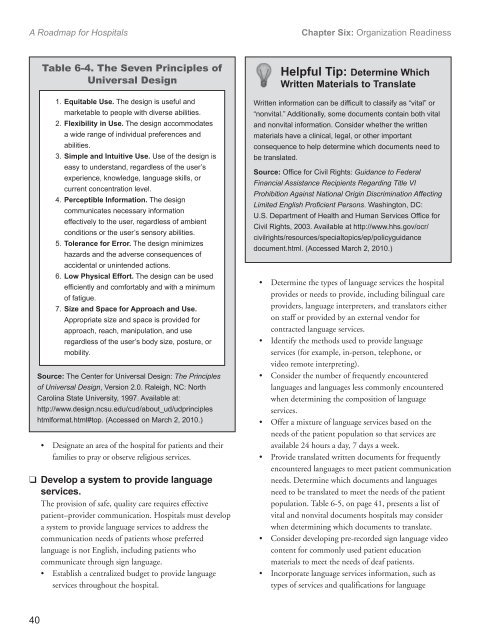
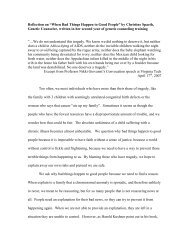
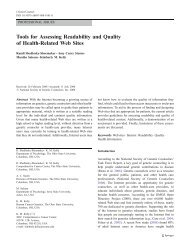

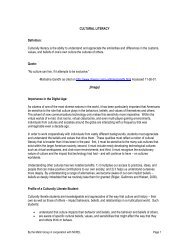
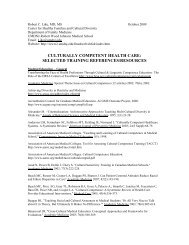

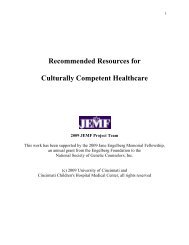

![Breaking Bad News PPT[1] - Genetic Counseling Cultural ...](https://img.yumpu.com/35003134/1/190x146/breaking-bad-news-ppt1-genetic-counseling-cultural-.jpg?quality=85)
